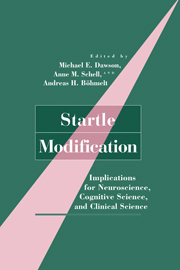Book contents
- Frontmatter
- Contents
- Contributors
- Preface
- Prologue: A Historical Note on the “Discovery” of Startle Modification
- 1 Startle Modification: Introduction and Overview
- PART I BASIC PARADIGMS, METHODS, AND PHENOMENA
- PART II PHYSIOLOGICAL MEDIATION OF STARTLE MODIFICATION
- PART III PSYCHOLOGICAL MEDIATION OF STARTLE MODIFICATION
- 7 Implications of Blink Reflex Research for Theories of Attention and Consciousness
- 8 Affect and the Startle Reflex
- PART IV INDIVIDUAL DIFFERENCES AND STARTLE MODIFICATION
- PART V RELATIONSHIPS WITH OTHER PARADIGMS AND MEASURES
- References
- Author Index
- Subject Index
8 - Affect and the Startle Reflex
Published online by Cambridge University Press: 26 March 2010
- Frontmatter
- Contents
- Contributors
- Preface
- Prologue: A Historical Note on the “Discovery” of Startle Modification
- 1 Startle Modification: Introduction and Overview
- PART I BASIC PARADIGMS, METHODS, AND PHENOMENA
- PART II PHYSIOLOGICAL MEDIATION OF STARTLE MODIFICATION
- PART III PSYCHOLOGICAL MEDIATION OF STARTLE MODIFICATION
- 7 Implications of Blink Reflex Research for Theories of Attention and Consciousness
- 8 Affect and the Startle Reflex
- PART IV INDIVIDUAL DIFFERENCES AND STARTLE MODIFICATION
- PART V RELATIONSHIPS WITH OTHER PARADIGMS AND MEASURES
- References
- Author Index
- Subject Index
Summary
ABSTRACT
Brief startle probes presented while people perceive emotionally evocative events are systematically and differentially modulated according to the affective valence of the foreground stimulus content: Unpleasant stimuli evoke a potentiated reflex to the startle probe that exceeds the normal reaction; pleasant stimuli occasion a relative inhibition of reflex magnitude. This chapter reviews theory and data relevant to affective modulation of the startle reflex. Properties of the startle probe (including sensory modality, intensity, aversiveness, task, timing, laterality, and response) and of the perceptual stimulus (including duration, repetition, blocking, intensity, and semantic or emotional category) are discussed as they impact on the pattern of affective startle modulation. Taken together, these studies elucidate further the nature of affective startle modulation, and provide support for the idea that the startle reflex is a useful measure of motivation and emotion.
Introduction: Affect and the Startle Reflex
The purpose of this chapter is to review data and theory relating to a relatively new phenomenon in the study of human emotional experience. Brief startle stimuli, presented as probes while people perceive emotionally evocative events, are systematically and differentially modulated according to the affective valence of the foreground stimulus content. Unpleasant stimuli evoke an augmented, potentiated reflex to the startle probe that exceeds the normal reaction; pleasant or appetitive stimuli occasion a relative inhibition of reflex magnitude.
Over several years of study, affective modulation of the startle reflex has proven to be highly replicable – a relatively rare event in psychological science. This reliability has made it a useful tool in investigating many critical issues in the study of emotion.
- Type
- Chapter
- Information
- Startle ModificationImplications for Neuroscience, Cognitive Science, and Clinical Science, pp. 157 - 184Publisher: Cambridge University PressPrint publication year: 1999
- 87
- Cited by



